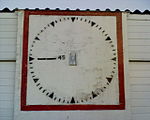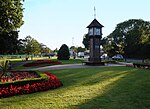Northolt Branch Observatories
Astronomical observatories in EnglandUse mdy dates from March 2020
The Northolt Branch Observatories (NBO; Observatory codes: Z80, Z48 and Z37) is an astronomical observatory located in London, England. NBO collects follow-up astrometry of near-Earth asteroids and other small Solar System objects. It focuses on public outreach, sharing images, videos and information about asteroids on social media. The two main belt asteroids 72834 Guywells and 128345 Danielbamberger are named after members of the Northolt Branch Observatories team.
Excerpt from the Wikipedia article Northolt Branch Observatories (License: CC BY-SA 3.0, Authors).Northolt Branch Observatories
The Heights, London South Harrow (London Borough of Harrow)
Geographical coordinates (GPS) Address Nearby Places Show on map
Geographical coordinates (GPS)
| Latitude | Longitude |
|---|---|
| N 51.55466 ° | E -0.37192 ° |
Address
The Heights
The Heights
UB5 4BS London, South Harrow (London Borough of Harrow)
England, United Kingdom
Open on Google Maps






